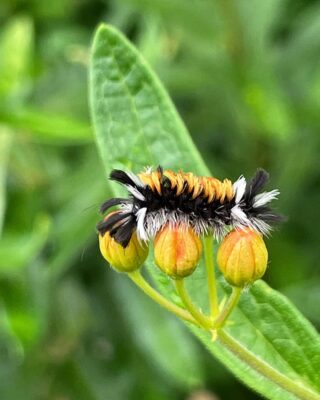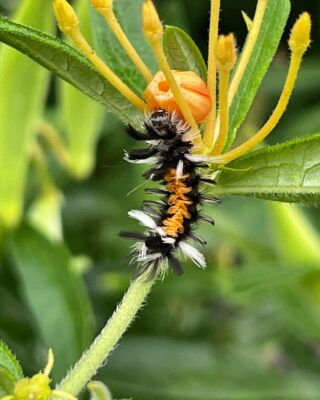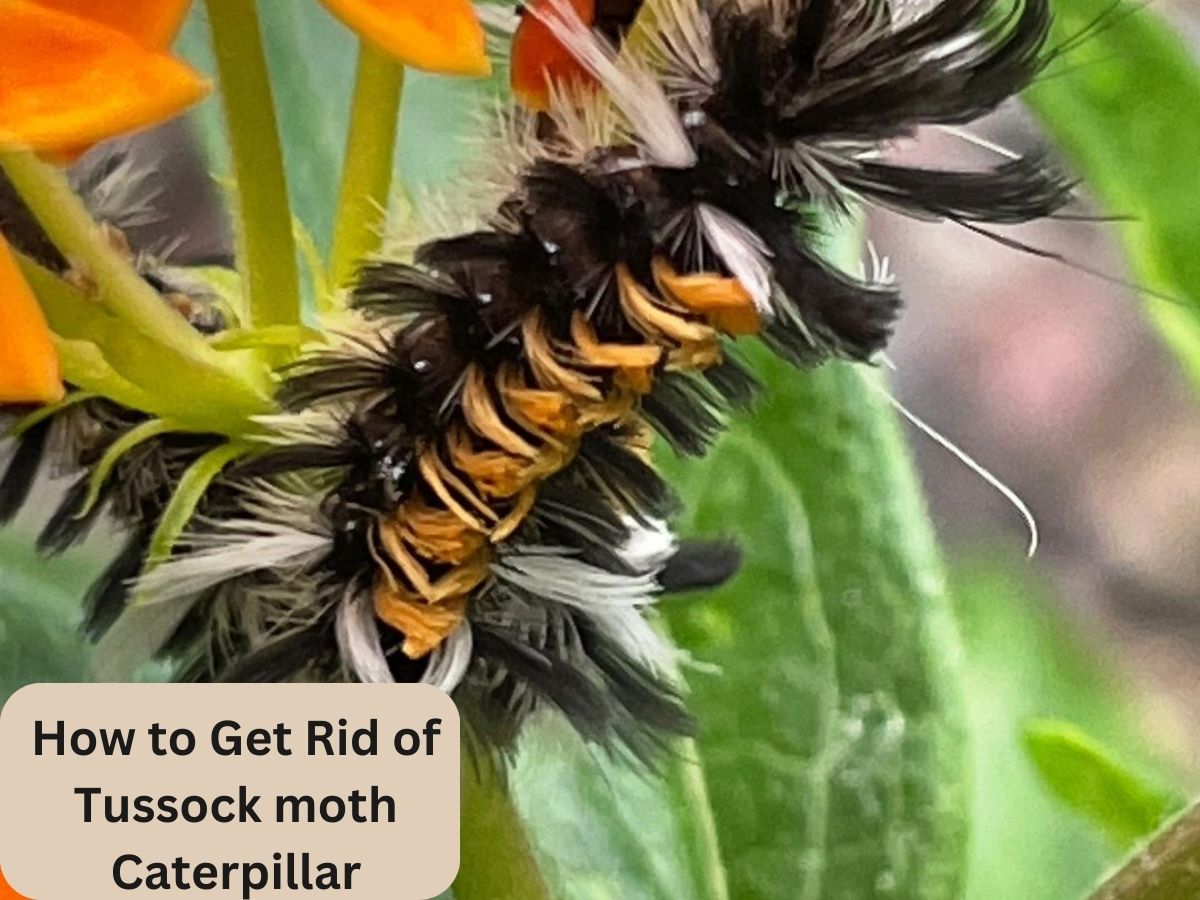Tackling a tussock moth caterpillar invasion in your garden? You’re not alone! These seemingly innocent creatures can wreak havoc on your plants, turning your lush greenery into a chewed-up battleground. But fear not, because, in this guide, we’re diving headfirst into the art of “How to Get Rid of Tussock Moth Caterpillars.”
From identifying these voracious eaters to arming yourself with effective and eco-friendly removal methods, you’re about to become a tussock moth caterpillar expert. Say goodbye to leaf-munching and hello to a thriving garden once again. Let’s roll up our sleeves and get these critters out of your sanctuary! ground.
Fret not – we’ve got your back. In this guide, we’ll unravel the mystery behind these tufted invaders and arm you with effective strategies to bid them farewell. From identifying the culprits to deploying natural, non-toxic solutions, you’ll be equipped to restore your plants to their former glory. Say goodbye to chewed leaves and unwelcome visitors – let’s dive into the world of battling tussock moth caterpillars head-on.
Signs of Infestation Tussock Moth Caterpillar
It’s like a miniature crime scene in your garden—unmistakable evidence left behind by tussock moth caterpillars. If you’ve been noticing leaves that look like they’ve been used as a buffet, along with some eerie silk threads hanging around, you might just have these critters as uninvited guests.
- Skeletonized Leaves: One of the glaring signs of a tussock moth caterpillar infestation is the “skeletonization” of leaves. These hungry caterpillars have an insatiable appetite, leaving behind leaves that resemble delicate lacework.
- Silk Threads: Another telltale sign is the presence of silk threads. These threads are spun by the caterpillars as they move around, leaving behind a distinctive mark on your plants.
- Frass (Droppings): These caterpillars are certainly messy eaters! Keep an eye out for their droppings, often referred to as “frass.” These little pellets can accumulate around the base of your plants, providing further evidence of their presence.
- Tufted Clumps: Once you’re familiar with their appearance, you might even spot the tussock moth caterpillars themselves. They sport colorful tufts of hair on their backs, making them quite the standout even amidst the foliage.
Remember, being a savvy detective in identifying these signs early can help you take swift action and prevent further damage to your garden.

Potential Damage
Prepare yourself for a plant-eating frenzy that tussock moth caterpillars are more than happy to deliver. These seemingly harmless creatures can wreak havoc on your garden and trees, causing a host of problems that might leave your green paradise looking less than picturesque.
- Defoliation: Tussock moth caterpillars are like nature’s lawnmowers but without restraint. They have an insatiable appetite for leaves, and if left unchecked, they can strip plants of their foliage in record time. This defoliation weakens the plants and hampers their ability to carry out essential processes like photosynthesis.
- Stress and Vulnerability: Plants that are subjected to repeated caterpillar feasting become stressed and more susceptible to diseases and other pests. With their natural defenses compromised, these plants are left open to a range of problems that can impact their overall health and vitality.
- Stunted Growth: Young plants or trees that are still establishing themselves can suffer even more severely. The loss of leaves can lead to stunted growth and a lack of proper development, which can have long-term consequences for your garden’s aesthetics and ecosystem.
- Reduced Flower and Fruit Production: For those plants that produce flowers and fruits, a caterpillar invasion can spell disaster. Reduced foliage means fewer resources available for flowering and fruiting, leading to a significant drop in the quality and quantity of the produce your garden yields.
- Ecosystem Imbalance: The delicate balance of your garden’s ecosystem can be disrupted by a large caterpillar population. As they consume plants, other species that depend on those plants for food or shelter might suffer, causing a ripple effect throughout the environment.
- Aesthetic Damage: Beyond the biological impact, there’s also the matter of aesthetics. A garden that’s been nibbled and stripped of its greenery doesn’t present the picturesque scene you’ve been striving for.
In short, the potential damage inflicted by tussock moth caterpillars is not to be underestimated. Taking swift action to control their population is essential to preserve the health and beauty of your garden.
How to Get Rid of Tussock Moth Caterpillar
When it comes to ridding your garden of those pesky tussock moth caterpillars, you’ve got an arsenal of methods at your disposal. Let’s dive into a range of effective strategies that will have your plants breathe a sigh of relief.
- Manual Removal: Put on your gardening gloves and get ready for some hands-on action. Regularly inspect your plants and physically remove caterpillars and their egg masses. Drop them into a bucket of soapy water to ensure they won’t come back for seconds.
- DIY Sprays: Your kitchen can be a treasure trove of caterpillar deterrents. Mix up a concoction using ingredients like neem oil, garlic, or mild soap diluted in water. Spray this solution on your plants to make them far less appealing to these leaf-munching intruders.
- Biological Insecticides: Nature can lend a hand in your battle. Biological insecticides like Bacillus thuringiensis (Bt) are your allies. When caterpillars ingest Bt, it disrupts their digestive system, eventually leading to their demise. This targeted approach avoids harming beneficial insects.
- Encourage Natural Predators: Nature has its pest control squad. Attract birds, ladybugs, and spiders to your garden by providing shelter and minimizing pesticide use. These natural predators will make a meal out of caterpillars, keeping their numbers in check.
- Use Sticky Bands and Barriers: Give caterpillars a taste of their own medicine. Wrap tree trunks with sticky bands or burlap to create physical barriers. Caterpillars crawling up will get caught, preventing them from reaching your plants.
- Optimize Plant Health: Healthy plants are better equipped to fend off attacks. Water, fertilize, and prune your plants correctly to ensure they’re strong and less vulnerable to caterpillar feeding.
- Prune Infested Areas: If you spot signs of infestation, don’t hesitate to prune heavily infested branches. This can prevent the infestation from spreading further and give your plants a chance to recover.
- Introduce Beneficial Insects: Release natural enemies like parasitic wasps that lay their eggs on caterpillars. Once the eggs hatch, the wasp larvae consume the caterpillar, effectively reducing their population.
- Horticultural Oil Sprays: Horticultural oils suffocate caterpillars by coating their bodies and blocking their spiracles (breathing pores). Apply these oils to infested plants according to the manufacturer’s instructions.
- Maintain Garden Hygiene: Clean up fallen leaves and debris regularly, as these can serve as hiding spots for caterpillars and their eggs.
Remember, a combination of these methods may yield the best results. It’s all about finding the approach that suits your garden’s needs and your commitment to eco-friendly practices. By taking proactive steps, you can bid farewell to tussock moth caterpillars and enjoy a flourishing garden once more.


Maintaining Plant Health
Think of plant health as your garden’s ultimate defense against unwelcome invaders like tussock moth caterpillars. Just like a well-nourished body can fight off illnesses, strong and thriving plants are more equipped to fend off these leaf-munching culprits. Here’s why maintaining plant health is your secret weapon:
- Resilience Against Stress: Healthy plants are like fitness buffs—they’re better at handling stress. When faced with caterpillar feeding or other challenges, robust plants have the energy reserves to bounce back quickly. They can tolerate the loss of a few leaves without it taking a severe toll.
- Enhanced Natural Defenses: Just like a balanced diet boosts our immune system, proper care enhances a plant’s natural defenses. Regular watering, appropriate fertilization, and optimal sunlight enable plants to produce chemical compounds that discourage pests and make them less palatable to caterpillars.
- Rapid Recovery: Caterpillar damage can slow down plant growth, but healthy plants are quick to recover. With a strong root system and ample nutrients, they’ll put their energy into regenerating new leaves and branches, minimizing the visible impact of the infestation.
- Chemical Signaling: Healthy plants can communicate effectively, even when under attack. They emit chemical signals that attract beneficial insects, like parasitic wasps, which prey on caterpillars. It’s nature’s way of recruiting allies in the battle against pests.
- Reduced Attractiveness to Pests: Just as a balanced diet can make us less appealing to mosquitoes, healthy plants are less attractive to caterpillars. Nutrient-rich leaves aren’t as tempting as stressed or weak ones, making your garden less likely to become a caterpillar buffet.
- Vigorous Growth: Strong plants are always on the move, growing, and thriving. This rapid growth makes it harder for caterpillars to keep up with their insatiable appetites. They simply can’t devour foliage at the same pace that healthy plants are producing it.
- Long-Term Defense: By investing in plant health, you’re setting the stage for a long-term defense strategy. Rather than fighting infestations reactively, your garden becomes a less favorable environment for pests, making it more resilient in the face of future challenges.
- Sustainable Gardening: Healthy plants support the ecosystem around them. Beneficial insects, birds, and microorganisms flourish in environments where plants are thriving. This harmony not only helps keep caterpillar populations in check but contributes to the overall health of your garden.
In the quest to outsmart tussock moth caterpillars, maintaining plant health is your proactive game plan. A well-cared-for garden not only makes for a stunning landscape but creates an environment that’s inhospitable to these leaf-loving invaders. It’s a win-win for both your garden’s aesthetics and its resilience.

How to Get Rid of Tussock Moth Caterpillar FAQs?
Are tussock moth caterpillars dangerous to humans?
Tussock moth caterpillars are generally not dangerous to humans in the sense of causing direct harm through bites or stings. However, they possess tiny, barbed hairs that can be irritating to the skin and cause allergic reactions in some individuals.
These hairs, known as setae, can break off easily and become airborne. If they come into contact with your skin, they might cause itching, rashes, or even mild irritation. To avoid any potential discomfort, it’s advisable to wear gloves and protective clothing if you need to handle these caterpillars.
Can I save an infested tree?
Yes, it’s possible to save an infested tree from the damage caused by tussock moth caterpillars, especially if you detect the infestation early and take appropriate measures. Start by identifying the level of infestation and assessing the health of the tree.
If the infestation is limited, manual removal of caterpillars by handpicking or using a brush can be effective. Pruning affected branches can also help to reduce the population.
Additionally, employing biological control methods like introducing natural predators or applying biological insecticides can help manage the infestation while minimizing environmental impact.
When is the best time to implement control measures?
The timing of control measures is crucial for their effectiveness. In most cases, it’s best to implement control measures during the caterpillars’ early developmental stages, typically in late spring or early summer.
During this time, caterpillars are more susceptible to control methods and haven’t caused significant damage yet. Identifying egg masses during the fall and winter seasons and removing them can also help prevent future infestations.
Are chemical insecticides the only effective solution?
Chemical insecticides are not the only solution for dealing with tussock moth caterpillar infestations, and they should be considered as a last resort due to their potential impact on beneficial insects and the environment. Integrated pest management (IPM) practices emphasize a holistic approach that includes natural predators, cultural controls, and organic methods.
These alternative methods can be highly effective in managing caterpillar populations. Biological insecticides, like those containing Bacillus thuringiensis (Bt), target caterpillars while being safe for other organisms. Additionally, horticultural oils, neem oil, and DIY organic solutions can provide effective control without resorting to chemical options.
Conclusion
Tussock moth caterpillars may pose a threat to your garden and trees, but with the right knowledge and strategies, you can effectively manage and control their population while maintaining the health of your outdoor space. Remember that a proactive approach, informed by a mix of methods, can make a significant difference in preventing infestations and minimizing damage.
Cultivating a healthy garden environment through proper planting, pruning, and maintenance practices serves as a foundation for prevention. Encouraging natural predators, such as birds and beneficial insects, can also lend a helping hand in keeping caterpillar populations in check.
When it comes to control measures, consider a range of options. Mechanical methods like handpicking or using barriers are eco-friendly and effective for smaller infestations. Biological insecticides and horticultural oils provide targeted solutions without harming the environment. DIY organic repellents can also play a role in your pest management toolkit.
While chemical insecticides remain a choice, remember that they should be your last resort due to potential unintended consequences. Prioritize integrated pest management (IPM) practices that combine various approaches for a well-rounded and sustainable solution. Always follow safety guidelines and local regulations when using any control method.
